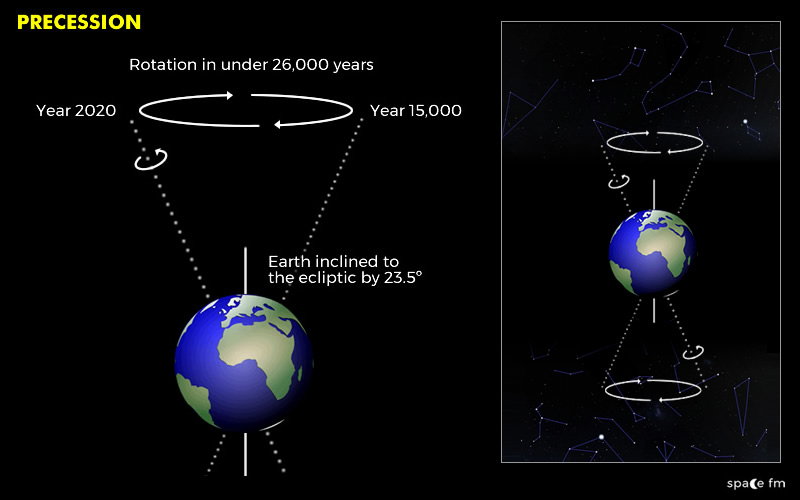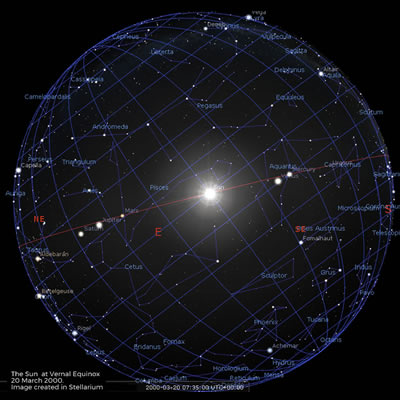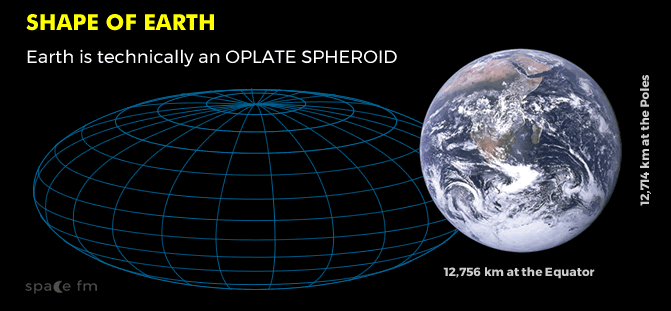Precession
3.6 - Understand how the gradual precession of the Earth’s axis affects the appearance of the Sun, Moon and stars, when observed from Earth....3.7 - Be able to use data relating to the rate of precession of the Earth’s axis
The Earth rotates on its axis but has a slight ‘wobble’ or ‘oscillation’ to be precise like a spinning top. This wobble takes approximately 26,000 years and has implications for how we view and measure the stars over a (very) long period. The process is known as precession of the equinoxes or axial precession.
Main Causes
Earth is not a perfect sphere and is an oblate spheroid, it is slightly wider at the equator. The Sun and Moon have a gravitational influence on Earth and this combined with the Earth’s bulge causes a wobble in the Earth’s tilt.
Discovery
Hipparchus in the 2nd century BC realised that some stars were not where they were meant to be. By studying records from past astronomers, he realised that there was a difference between the time it takes for the sun to return to a star (sidereal year) and then time it takes to return to the same place on an equinox (tropical year). The point of the equinox was therefore moving backwards. Isaac Newton knew Earth was not a classical sphere and had an equatorial bulge. He understood the Sun and Moon are pulling on the Earth particularly the bulge and this distorts its axial movement.
What it means
Measurements of a star’s longitude (right ascension) are taken from the point where the sun appears to cross the celestial equator at the vernal equinox (spring in the northern hemisphere). What happens is that there is a slight shift every year and the point moves westwards along the ecliptic. Star positions are republished every 50 years in star catalogues to take this into account.
Celestial Pole Location
We know Polaris marks the North Celestial Pole although it was not always so. Thuban was the nearest pole star thousands of years ago and Vega will be the brightest equivalent to Polaris in 14,000 years time. The current South Celestial Pole is marked by a star, Sigma Octantis which at magnitude 5.5 is too difficult to see under normal conditions. In the future the pole will be marked by several bright stars.
Viewing
The effects over the course of a precession cycle on observing is that the celestial poles move and all stars therefore shift ever so slightly from one year to the next. This is only noticeable to the casual naked eye observer over millennia but if it was possible, they would see that the area of stars from their location that were circumpolar on one date would be different in many years afterwards. They would also see a different range of seasonal stars to boot. Fixed monuments, which you will see on the Archeoastronomy page, aligned to celestial markers thousands of years ago will show a deviation in what they were originally designed to do.
Other Causes and Effects
There are other factors that astronomers have to take into account when studying precession.
- The Earth has anelliptical orbit
- The Moon has its own precession
- The Moon has an orbit around Earth at a different degree of inclination to the ecliptic
- Other planets have precession of their own to some degree and their own elliptical orbits which have an effect on the ecliptic itself
- The Earth’s tilt varies from 22.1 to 24.5° every 41,000 years.
Precession can be a complicated business. If you do further research you will find some of these listed as lunisolar precession, planetary precession and precession of the ecliptic. There are also two other factors regarding Earth’s tilt called nutation and polar motion. You can find out about these too. For a laugh. Note: When researching take care as many articles are concerned with astrology and not necessarily astronomically accurate.
Exact figures
Earth's diameter is approximately 13,000km wide
Earth's axial tilt = 23.436°
Circle of Precession = 25,772 years
Questions
Question 1
How long does it take for the rate of precession to move 1 degree?
Check AnswerA precession circle takes approx. 26,000 years
Divide that by 360°
=72 years
Question 2
By how much does it move per year?
Check AnswerA precession circle takes approx. 26,000 years. Divided by 360° = 72 years to move 1 degree
So we need to figure out 1 degree divide 72
That’s tricky how do we split 1 degree by 72. We use arc seconds of course, silly. There are 3600 arc seconds (60 x 60 arc minutes) in 1 degree.
3600 divide 72 = 50. Answer is 50 arc seconds per year.
Did you know?
Often the periods where the Sun is in a constellation is called an age. So we are now in the 'Age of Pisces'.
Did you ALSO know?
Links
Skywise Unlimited Precession of the Equinox
EAAE Summerschools Hipparchus and the Precession of the Equinoxes







 | © All Rights Reserved |
| © All Rights Reserved |